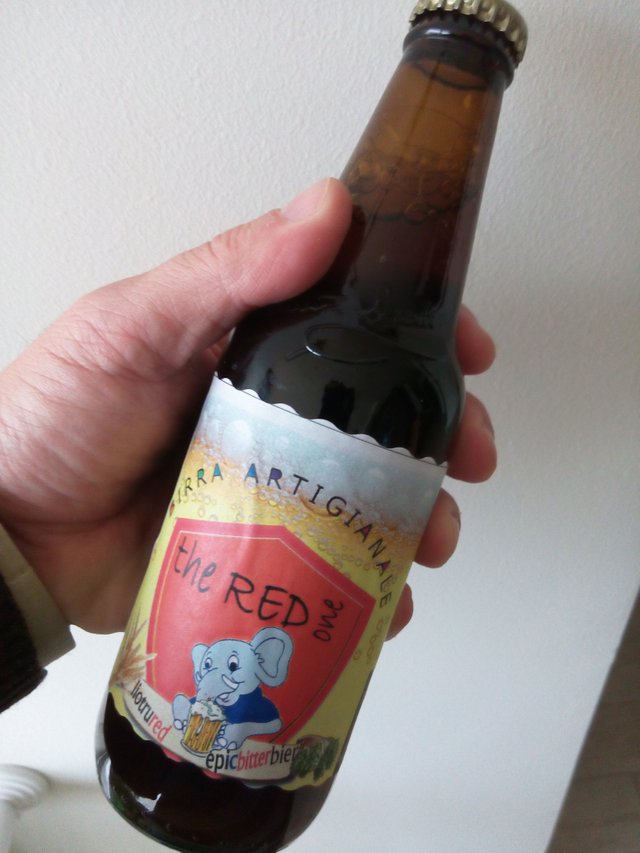Riprendo con piacere la serie degli articoli sulla birra.
La breve pausa sull’argomento mi è servita per rimettere un po’ in fila le idee, verificare quanto pubblicato sul tema e verificare ulteriori argomenti su cui scrivere.
Parlerò oggi degli elementi base della birra.
Gli elementi della birra, quelli di base, sono quattro: l’acqua, l’orzo, il luppolo (o i luppoli) e i lieviti.
Combinando questi quattro elementi si ha la birra.
Analizziamoli.

la mia prima rossa - LiuotruRed - foto dell'autore
L’acqua. È l’elemento essenziale e quello da un punto di vista quantitativo più presente. Circa il 90 -93% della birra è formata da acqua. È fondamentale conoscere le caratteristiche dell’acqua utilizzata perché questa influenzerà l’intero processo produttivo.
Gli elementi presenti nell’acqua influenzeranno le proprietà organolettiche della birra.
Provate a scorgere in una bottiglia di acqua oligominerale o minerale quanti elementi sono presenti.
L’acqua di Plzen, nella repubblica Ceca, contiene pochissimo calcio e pochissimi carbonati, per cui è ideale per le birre tipo Pilsner, solitamente leggere, bionde, luppolate.
Al contrario l’acqua della cittadina di Burton on Trent in Inghilterra è particolarmente dura ricca di carbonati e di ioni solfati che aumentano l’amaro del luppolo e aggiungono un certo corpo ma anche secchezza alla tipologia di birra prodotta in quel territorio cioè la Bitter style.
L’orzo. È il cereale più utilizzato ed il più adatto alla produzione della birra. È un cereale di qualità. È posto a macerare in acqua fino a quando non nascono le radichette in ogni chicco.
Questo processo che viene definito maltazione serve a far acquisire ai singoli chicchi gli zuccheri cosidetti malto-destrine che saranno poi cibo per i lieviti.
L’orzo così germogliato viene prima essiccato e poi torrefatto. A seconda del grado di torrefazione il cereale sarà più o meno abbrustolito, o meglio tostato. In questa fase cambia di colore fino al raggiungimento di colori molto scuri, quasi neri per gli stili stout e porter.
Dopo la vendita in sacchi del prodotto alle fabbriche di birra avviene la macinatura ovvero la spezzettatura in piccole parti. Non in polvere, mi raccomando.
I resume the series of beer articles with pleasure.
The short break on the subject served me to put the ideas back in a row, check what was published on the subject and verify further topics to write about.
I will talk today about the basic elements of beer.
There are four basic elements of beer: water, barley, hops (or hops) and yeasts.
Combining these four elements one has the beer.
Analyze them.
The water. It is the essential element and that from a quantitative point of view more present. About 90% -93% of beer is made up of water. It is essential to know the characteristics of the water used because this will affect the entire production process.
The elements present in the water will influence the organoleptic properties of the beer.
Try to see in a bottle of mineral water or mineral how many elements are present.
The water from Plzen, in the Czech Republic, contains very little calcium and very few carbonates, so it is ideal for Pilsner type beers, usually light, blond, hopped.
On the contrary, the water of the town of Burton on Trent in England is particularly hard, rich in carbonates and sulphate ions which increase the bitterness of the hops and add a certain body but also dryness to the type of beer produced in that territory.
Barley. It is the most used cereal and most suitable for the production of beer. It is a quality cereal. It is placed to macerate in water until the rootlets are born in each grain.
This process which is called maltation is used to make the single grains acquire the so-called malt-dextrin sugars, which will then be food for the yeasts.
The sprouted barley is first dried and then roasted. Depending on the degree of roasting, the cereal will be more or less toasted, or better toasted. In this phase it changes color until it reaches very dark colors, almost black for the styles** stout** and porter.
After the sacks of the product are sold to the breweries, the grinding takes place in small pieces. Not powdered, I recommend.
Mi hai fatto venir sete, e pur non essendo un accanito bevitore di birra, nel frigo ce n'è sempre una, la stappo alla tua salute!!
Downvoting a post can decrease pending rewards and make it less visible. Common reasons:
Submit
Non sapevo che l'acqua fosse elemento cosi determinante nel gusto di una birra. Immagino che ci siano dei processi per purificare la stessa in funzione del risultato finale desiderato.
Downvoting a post can decrease pending rewards and make it less visible. Common reasons:
Submit
osmosi, si applica quella regolando i valori che vuoi ottenere...
Downvoting a post can decrease pending rewards and make it less visible. Common reasons:
Submit